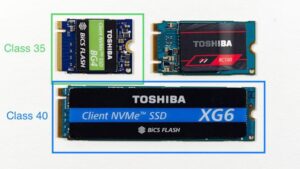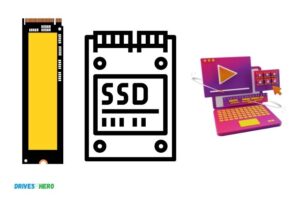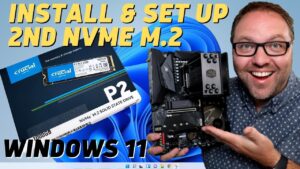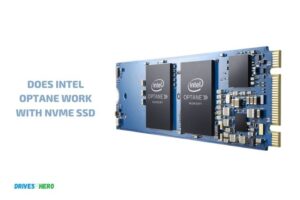Sata 3 Ssd Vs Nvme: Which One is Right for You?
When comparing SATA 3 SSDs and NVMe SSDs, NVMe SSDs are significantly faster in terms of performance, data transfer speed, and latency.
SATA 3 (Serial ATA) SSDs and NVMe (Non-Volatile Memory Express) SSDs are two different types of solid-state drives that serve as data storage devices.
SATA 3 SSDs use the SATA interface, which was originally designed for spinning hard disk drives.
On the other hand, NVMe SSDs use the PCIe interface, which was specifically designed for high-speed, non-volatile storage devices, like SSDs.
This fundamental difference in design and interface leads to a stark contrast in performance between the two types of SSDs.
In conclusion, when choosing between a SATA 3 SSD and an NVMe SSD, it is essential to consider the specific needs and budget constraints of the user. While NVMe SSDs offer significantly faster performance, data transfer speeds, and lower latency, they also come with a higher price tag.
9 Features: Sata 3 Ssd Vs Nvme
| Feature | SATA 3 SSD | NVMe |
|---|---|---|
| Interface | SATA 3 (6 Gbps) | PCIe (up to 4.0) |
| Form Factor | 2.5-inch, M.2, mSATA | M.2, U.2, PCIe card (AIC) |
| Speed | Up to 600 MB/s | Up to 7,000 MB/s (PCIe 4.0) |
| Latency | Higher latency | Lower latency |
| Protocol | AHCI | NVMe |
| Bootable | Yes | Yes |
| Typical Usage | Consumer, mainstream | High-performance, enterprise |
| Power Efficient | Less power-efficient | More power-efficient |
| Price | Generally cheaper | Generally more expensive |
Key Takeaway
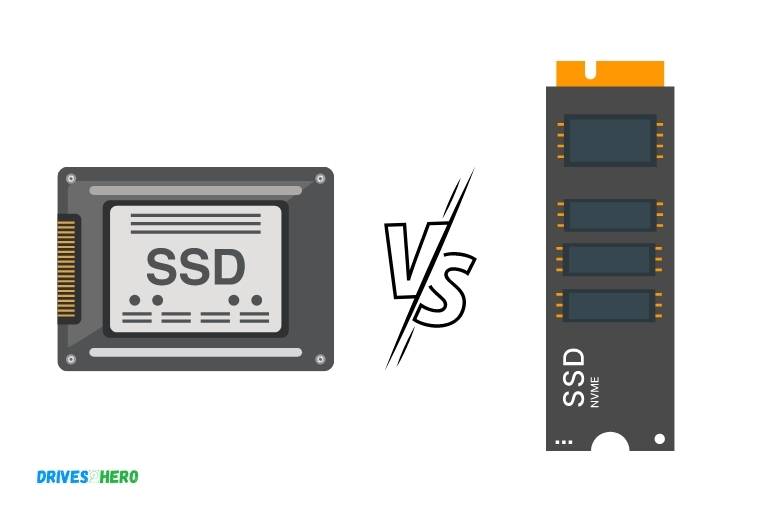
Five Facts About Sata 3 Ssd & Nvme
Understanding The Difference Between Sata 3 Ssd And Nvme
Solid-state drives (ssds) are becoming more and more popular in the tech industry. Thanks to their speed and durability, ssds have a significant advantage over traditional hard disk drives (HDDs).
In this blog post, we will explore the difference between two popular ssd interfaces: sata 3 ssd and nvme.
What Is Sata 3 Ssd?
Serial ata (sata) is a commonly used interface for connecting storage devices to a computer’s motherboard. Sata 3 ssd is an ssd that uses the sata interface for data transfer.
Here are some key points about sata 3 ssd:
- Sata 3 interface has a maximum theoretical speed of 6 gigabits per second (gbps).
- Sata 3 ssds are compatible with most computers that have a sata interface.
- Sata 3 ssds are available in different form factors, including the popular 2.5-inch drive.
What Is Nvme And How Does It Differ From Sata 3 Ssd?
Non-volatile memory express (nvme) is a newer interface specifically designed for ssds. Nvme ssds offer faster transfer speeds than sata-based ssds due to the interface’s ability to use the pcie bus more efficiently.
Here are some key points about nvme:
- Nvme has a maximum theoretical speed of 32 gbps.
- Nvme ssds are usually in the m.2 form factor, which allows for faster transfer speeds than sata-based ssds.
- Nvme ssds require a compatible pcie interface to work.
- Nvme ssds are not backward compatible with older motherboards that lack a pcie interface.
Sata 3 Ssd Vs Nvme: The Technical Differences
When it comes to choosing an ssd interface, there are some technical differences that you should be aware of.
Here are the main differences between sata 3 ssd and nvme:
- Speed: Nvme is significantly faster than sata 3 ssd. Nvme can achieve over 3000 mb/s sequential read speeds, while sata 3 ssd tops out at around 550 mb/s.
- Compatibility: Sata 3 ssds are compatible with most computers that have the sata interface, while nvme ssds require a pcie interface to work.
- Form factor: Sata 3 ssds are available in a range of form factors, including the popular 2.5-inch drive, while nvme ssds are usually in the m.2 form factor.
- Price: Nvme ssds are more expensive than sata 3 ssds, but the speed advantage may be worth the extra cost for some users.
Nvme ssds offer superior speed and performance when compared to sata 3 ssds. However, sata 3 ssds remain a popular choice due to their compatibility with most computers and their lower price point.
It ultimately comes down to personal preference and budget when choosing between the two ssd interfaces.
Performance Comparison Between Sata 3 Ssd And Nvme
Sata 3 Ssd: Speed And Performance
Sata 3 ssd, or serial ata solid-state drive, is a drive that uses the sata interface, which is the same interface as most traditional hard drives.
Here are the key points to know about sata 3 ssd speed and performance:
- Sata 3 ssds offer faster data transfer rates than traditional hard drives.
- They have faster read and write speeds than traditional hard drives, which results in faster boot times and applications opening quicker.
- Sata 3 ssds have a lower cost compared to nvme ssds.
- These drives consume significantly less power than mechanical drives, which in turn requires less cooling.
- The sata interface limits the maximum transfer rates which can drop the speed of the ssd.
Nvme: Speed And Performance
Nvme, or non-volatile memory express, is an interface standard designed exclusively for solid-state drives.
Here are the key points to know about nvme speed and performance:
- Nvme interface is more efficient than sata and provides higher transfer speeds due to more significant bandwidth.
- It uses a parallel data transfer interface and supports high-speed ssds.
- It has faster reading and writing speeds than sata 3 ssd, which results in faster boot times, quicker application launches, and system responsiveness.
- Nvme is used mostly for high-performance workloads such as gaming or video editing, where large files are frequently transferred.
Sata 3 Ssd Vs Nvme: Benchmark Comparison
Sata 3 ssds and nvme have some similarities and differences when it comes to speed and performance.
Here is a benchmark comparison of these two types of drives:
- When tested with sequential read and write, nvme showed significantly faster read and write speeds than sata 3 ssd.
- On the other hand, the random read and write speeds were not significantly different between the two drives.
- The loading times and boot-up times on nvme drives were noticeably faster than sata 3 ssds, with the margin increasing as file sizes get bigger.
- Nvme drives have lower latency and higher throughput than sata 3 ssds.
Both sata 3 ssds and nvme have their benefits when it comes to speed and performance. Sata 3 ssds are ideal for basic computing tasks, while nvme should be used for more intensive tasks such as gaming or video editing.
The benchmark comparison shows that nvme is the best choice for speed and performance, but sata 3 ssd is the more affordable option.
Sata 3 Ssd Vs Nvme: Which Storage Option Is Best For You?
Are you tired of slow load times and outdated storage devices? If so, it might be time to upgrade your computer’s storage.
However, with so many options to choose from, it can be challenging to decide which one to go with.
In this blog post, we’ll be discussing the two most popular options: sata 3 ssd and nvme, and which option is best for you.
Sata 3 Ssd: Advantages And Disadvantages
Sata 3 ssds have been around for quite some time and are known for their affordability, reliability, and compatibility with most devices.
Here are some advantages and disadvantages of using sata 3 ssds:
| Advantages: | Disadvantages: |
| ✔ Affordable compared to other storage options. ✔ Compatible with most devices, including older ones. ✔ Reliable and widely available in the market. | ✔ Lower read and write speeds compared to newer storage devices. ✔ Can be a bottleneck for high-end systems that require fast transfer speeds. |
Nvme: Advantages And Disadvantages
Nvme, on the other hand, is a relatively new storage technology that offers lightning-fast read and write speeds. However, it’s also expensive and might not be compatible with older devices.
Here are some advantages and disadvantages of using nvme:
| Advantages: | Disadvantages: |
| ✔ Extremely fast read and write speeds, making it ideal for high-end systems. ✔ Lower latency compared to sata 3 ssds. ✔ Has support for features like trim and garbage collection, optimizing the device’s performance. | ✔ Expensive compared to other storage options. ✔ Might not be compatible with older devices and systems. ✔ Limited storage capacity compared to other storage options. |
Which One Should You Choose—Sata 3 Ssd Or Nvme?
Choosing between sata 3 ssd and nvme depends on your needs. If you’re on a tight budget and looking for a reliable and affordable storage option, then sata 3 ssd is an excellent choice.
On the other hand, if you’re looking for lightning-fast read and write speeds for high-end systems, and don’t mind paying a premium price, then nvme is the way to go.
The Factors To Consider When Choosing Between Sata 3 Ssd And Nvme
Here are the factors to consider when choosing between sata 3 ssd and nvme:
- Compatibility: Check if the storage device is compatible with your device’s motherboard and processor.
- Budget: Consider the cost of the storage device and assess if it fits your budget.
- Storage needs: Determine the amount of storage you need and choose a device that fits your requirements.
- Performance: Assess your device’s performance requirements and choose a device that can meet those needs.
Sata 3 ssd and nvme are both excellent storage options, and the choice depends on your needs and preferences.
Consider the factors mentioned above, weigh the advantages and disadvantages of each storage option, and make an informed decision that will enhance your device’s performance.
Upgrading Your Pc From Sata 3 Ssd To Nvme
If you’re looking to improve your computer’s performance, upgrading your storage is always a good place to start.
Sata 3 ssds have been the standard for a while now, but the faster nvme ssds are becoming increasingly popular. In this section, we’ll discuss everything you need to know about upgrading from sata 3 ssds to nvme ssds.
Can You Upgrade Your Current Sata 3 Ssd To Nvme?
Unfortunately, you can’t simply plug an nvme ssd into a sata 3 port and expect it to work.
The two types of drives use different connectors, so you’ll need to ensure that your motherboard actually supports nvme drives.
To find out if your motherboard is compatible, check your motherboard’s manual or the manufacturer’s website.
How To Upgrade From Sata 3 Ssd To Nvme
If your motherboard does support nvme drives, congratulations! You’re one step closer to faster storage speeds.
Here’s how to upgrade:
- Purchase a nvme ssd that fits your needs. There are many options available, so consider factors such as size, capacity, and price.
- Back up your data. Before you start the upgrade process, it’s important to backup your important files and folders to ensure you don’t lose any data during the process.
- Install the nvme ssd onto your motherboard. This step will vary depending on your specific motherboard but typically involves removing a screw or two to unlock the mounting bracket, sliding the nvme drive into place, and tightening the screw(s).
- Boot up your computer and enter the bios. From there, navigate to the boot tab and set the nvme drive as the new boot drive. Save changes and exit the bios.
- Install your operating system onto the new nvme drive. Once you’ve set the nvme drive as the boot drive, you’ll need to install your operating system onto the new drive. This step will depend on your specific operating system, but it typically involves creating a bootable usb drive and following the installation prompts.
What Are The Benefits Of Upgrading Your Ssd To Nvme?
Now that you’ve upgraded to an nvme ssd, you might be wondering what benefits you’ll see.
Here are some of the top benefits:
- Faster speeds: Nvme ssds are capable of much faster read and write speeds than sata 3 ssds, so you’ll experience faster boot times, faster file transfers, and faster load times in applications and games.
- Increased productivity: With faster read and write speeds, you’ll be able to work more efficiently and get more done in less time.
- Less power consumption: Nvme drives use less power than sata 3 drives, which means your laptop’s battery life may improve.
- Future-proofing: Nvme is the future of storage, so by upgrading now, you’ll be ready to take advantage of faster storage speeds as they become available.
Overall, upgrading from sata 3 ssd to nvme is a great way to breathe new life into an older machine or improve the speed of a newer one.
With the benefits of faster speeds and improved productivity, it’s definitely worth considering if you’re looking to upgrade your storage.
Frequently Asked Questions For Sata 3 Ssd Vs Nvme
What Is The Difference Between Sata 3 Ssd And Nvme?
Sata 3 ssds transfer data at up to 600mb/s, while nvme can go up to 3500mb/s.
Is Nvme Ssd Faster Than Sata 3?
Yes, nvme provides faster read and write speeds than sata 3 ssds due to its advanced technology.
Can Nvme Work With Sata 3?
Yes, nvme ssds can work with sata 3, but they won’t provide the full performance benefits of nvme.
Which One Is Better For Gaming, Sata 3 Ssd Or Nvme?
Nvme ssd is a better choice for gaming because it provides faster load times and increased performance.
Conclusion
After analyzing the differences between sata 3 ssd and nvme, it’s evident that choosing between the two solely depends on your requirements. If you’re in need of high performance and faster data transfer rates, nvme is the way to go.
However, if you’re on a tight budget and require a decent storage performance for basic tasks, sata 3 ssd won’t disappoint you.
Both sata 3 ssd and nvme drives have their own pros and cons, and it ultimately boils down to your personal preference.
But, one thing is for sure, ssd drives are much faster than traditional hdds, and nvme drives are on the forefront with their advanced features in the industry. So, investing a little extra in an nvme drive might be worth it in the long run.
We hope this article helps you make an informed decision when selecting a storage drive for your system.
Before making your final decision, take a minute to evaluate your requirements, weighing out the pros and cons of each.
Thank you for reading, and we wish you the best of luck on your journey in finding the perfect storage drive for your needs!

